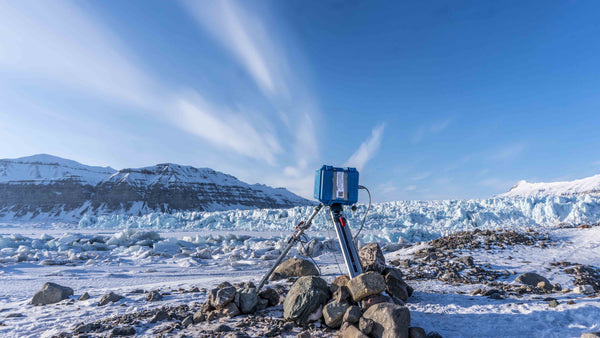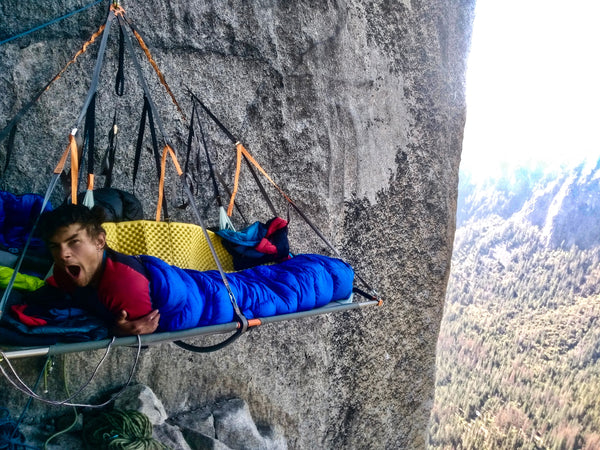Stories from the land of wind. Patagonia

I’ll walk to the end of the street and take a picture of Fitzroy. Are you coming?
Nope, I don’t want a picture of Fitzroy. I want a picture of El Chalten from the summit of Fitzroy!
Time in El Chalten has another dimension, and most of your day is spent praying to the internet and weather Gods to be merciful. And they are not. But sometimes they get tired, and that’s when your opportunity arises. This season they were strong, but we brought special skills, and we were ready to fight. A mathematical approach (at least from our point of view) to the weather forecasting, secret interpretation of the weather models and magic potions from LYOFOOD.
Aguja Poincenot – 3002 m – Whillans-Cochrane Route – 550 m, 5+, 70°, M4, 1962
First opportunity arrived on the 10 January. Weather model showed a 1.5 days window, with low wind, first day mild temperatures, followed by half a day of cold weather, but stronger wind. Then, the wind will pick up again.

Aguja Poincenot stands few hundred meters south of Fitzroy and was on our climbing list. Both summits are visible from El Chalten, when weather allows. If not, postcards are available in the local shops for 30 pesos. Poincenot is the smaller sister of Fitzroy and also a perfect observation point to study the conditions on his bigger sibling.
We left town early in the morning to avoid sun and hordes of tourists that go up to Laguna de Los Tres. Few tourist pictures, then crossed the small river, went around the lake and headed up and down the slabs towards the glacier. To our surprise the snow on the de Los Tres glacier going up to Paso Superior was hard enough, so we continued. Considering that other parties might have occupied the best bivi places in Paso Superior, and not having a shovel to level a platform for the tent, we bivied below Paso Superior, on some rock outcrops on the ridge, close to an empty tent. The Argentinian climbers arrived at their tent late in the evening. They wanted climb Poincenot, but were forced to bail as snow was soft and ice was melting. Not encouraging, but we were strong in our minds.

Few hours of sleep passed quickly and 2:00 am the alarm rang. Quick breakfast and half an hour later we were already climbing up to Paso Superior. Few other teams started from Paso Superior with the same goal, so we were not alone. The ramp that defeated me 3 years ago and the Argentinian team one day before was in almost perfect conditions and we advanced quickly, running away from the direct sunlight. We expected dry conditions on the west face, but we climbed icy cracks and rime, with short dry tooling moves right to the summit ridge. Strong winds welcomed us on the summit closing the window behind us. Few minutes and a couple of pictures afterwards we start abseiling.

Most of the ice we climbed hours before was melted, and hard snow on the ramp transformed into knee deep sugar. All other teams retreated. We were back on the Piedras Blancas glacier in the afternoon and back to our bivi place soon afterwards. We took a short break to melt snow, hydrate, eat and pick up the bivi equipment we left in the morning, then continued to the Campamento Rio Blanco, a small three-wall shelter where we spent the night. Next day in the morning we were back in El Chalten, and joined the routine: chipas, internet – weather forecast, empanadas, weather forecast, weather forecast, again weather forecast, asado, wine, weather forecast, climbing at the local crag, weather forecast, walk to the end of the street and take a photo of Fitzroy… weather forecast again.

Cerro Fitzroy 3405 m – Comensana –Fonrouge, 1600 m, 5+, M5, 80°, 1965
And finally a window was coming again! This new window looked perfect for the main objective: Maros wanted a picture of El Chalten from the summit of Fitzroy. Initially a 4 day window with low temperatures, slowly changed into a 3 days window, which proved to be a 2 days window delayed by 1 day. Did you get it? Don’t worry. At some point we were sure that the meteorologists working on the models were just making fun on some fool climbers. But the picture was important, so we went.
The plan was simple: day 1 approach from El Chalten to base of Supercanaletta, day 2 summit and then quickly go down on the other side. Sticking to the plan was not that easy. Day one we bivied twice on our way to Piedra Negra, a bivuac place half distance between Rio Electrico and base of our route. Rain, snow, wind, we had everything. And this was supposed to be the best day. Next day alarm rang at 2:00 am as usual, but wind was strong. At 3:00 am we opened the tent: 20 cm of fresh snow, so we stayed. Day 2 was bad. No visibility, wind, some snow, lots of doubts. We go, we stay, we go back to town, maybe we go... In the afternoon we went. Snow was good on the Fitzroy Norte glacier and we moved relatively quickly, mostly unroped. In the evening we were at the base of Supercanaletta. Suddenly the sky cleared and we were able to see almost all the entire gully. The decision came quickly, there were no more doubts. We had to take the picture!

We ate Sean Villanueva’s nettle curry from our selection of LYOFOOD's finest dishes, hoping to become at least as strong as he is. Then we went to sleep for a couple of hours. Just after midnight the alarm rang again. We packed the tent, sleeping bags, melted some snow… this is climbers night routine. We quickly started solo climbing the gully. Conditions were good but could be better. Half way into the Supercanaletta gully we roped up and continued mostly simul-climbing. There was one team in front of us, which we caught. Then 2 more teams caught us. Below the mixed section after “bloque emportado” we rested and melted snow. Then pitches followed one by one until we stopped counting. The topo said 1000 m of icy gully followed by 19 pitches of climbing. But with every step the summit was getting closer. One last almost vertical, dry-tooling pitch, then one short abseil on the other side. By early evening we were at the col, and we were sure we’ll get to the summit. We unroped and climbed easy mixed and icy terrain. It was getting dark when I joined Maros on the summit. More than 20 hours of almost continuous climbing, we were tired, but happy. Maros took the picture he came for: the picture of El Chalten from the summit of Fitzroy!

That night we picked our tent and slept few meters below the main ridge, very close to the summit. Next day we abseiled down via the Franco-Argentina route, aka the Rope Eating Route. This is probably as challenging as the climbing itself. We had our ropes stuck almost every abseil. We reached the Piedras Blancas glacier in the afternoon, then walked via Paso Superior and Laguna de Los Tres to Campamento Poincenot where we decided to spend the night. Next day we were back in town. We had the picture!
We now climbed the two main summits on the 30 pesos postcards.

For the first time since our arrival, we did not care for the weather forecast anymore. OK, at least for some days, until the wind slowed down and the next window was showing. This would be our last trip into the mountains before our departure, and we chose a remoted, rarely visited objective:
Cerro Huemul 2550 m, End of Faith with variations -Colin Haley – Alex Honnold, 1000 m, 3-4, M4, 2016
This climb, without being a major technical objective, was a real adventure and had everything.
We started from Bahia Tunel in the afternoon and followed a trail passing private properties, then traversed Rio Torro via a Tyrolian. We joined a cattle path going up towards the East Ridge, through open fields, pampas, forests, meadows, then loose scree. When the night arrived we installed our light tent half an hour away from the start of the main ridge on a place that looked exactly as the place where Neil Armstrong landed on the Moon almost 50 years ago.


Next day we decided we are too lazy to walk to the start of the main East Ridge and started our climb from the north-east, climbing poor rock gullies and scree, then ridges, traversing over pinnacles, eventually joining the “End of Faith” route and the main ridge after 400 m. We continued on the ridge, mostly soloing grade 3-4 terrain, excepting for approximately 150 m where we used a rope, but no protection. We summited early in the afternoon, then almost run down the North Face. We arrived at the foot of Cerro Huemul, 1 hour apart, following different descend routes, each of us with his own little adventure. Getting lost is a real option. Then, we decided that we need to add more taste to our adventure and tried to traverse Rio Torre in different places, in waist deep water. In the end this proved to be a bad idea. In the end, soaked to the bones, with hundreds of small spikes in our skin, we were forced to bivi again on the wrong side of Rio Torro, right at the place we passed several hours before, at the bottom of our descent route. Next day we went up Rio Torro, passing slippery, polished slabs, around Laguna Torro, crossed a short Tyrolian and joined El Chalten many hours later. We had good weather, almost no wind, and amazing view over Hielo Continental and its thousands of peaks, most of them never climbed.

Back in town we were surprised to find out that very few people managed to climb that day, as the weather was atrocious. Not to us!
Mihnea Radulescu










